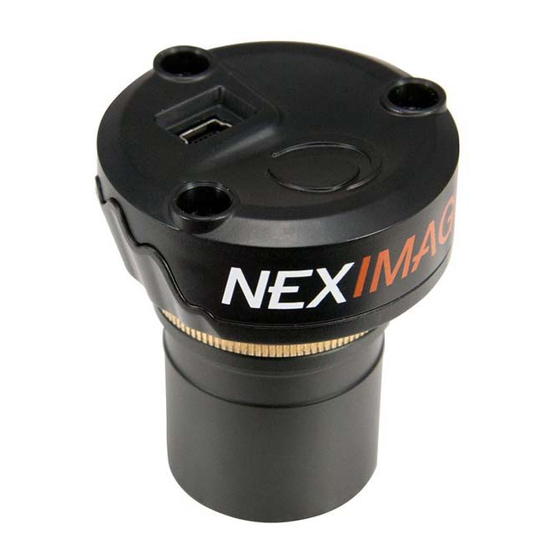
Advertisement
Table of Contents
Advertisement
Table of Contents

Summary of Contents for Celestron Neximage 5
-
Page 1: Users Manual
Users ManUal Model #93711 English... - Page 2 Congratulations on your purchase of the Celestron NexImage 5 Solar System imaging camera. Your neximage camera comes with the following: + NexImage 5 Camera + 1.25” nose piece + CD including NexImage iCap and RegiStax processing software + USB Cable...
-
Page 3: Quick Start
Quick start 1. Place the CD into your computer’s CD rom drive. 2. Install both the NexImage iCap and RegiStax software onto your computer. 3. Thread the 1.25” nose piece into the body of the NexImage camera. see Fig 2. Fig 2 4. -
Page 4: Capturing Images
Fig 4. Fig 4 2. If the NexImage 5 camera is not already detected, select the camera and press OK. see Fig 5. Fig 5 3. Select an easy target like the moon to begin with. Center and focus your telescope on the specific feature you wish to image. - Page 5 5. Use the telescopes focuser to focus the image until object is visible and sharp. see Fig 6. Fig 6 Fig 7 6. Use the Gain (A) and Exposure (B) settings to make sure that the image is not under or over exposed. 7.
- Page 6 10. Press the Video File (E) to select the destination location for your video. 11. Click on the Advanced tab. You can either select the amount of time or number of frames you wish to record. see Fig 9. Fig 9 12.
-
Page 7: Processing Images
Processing images Fig 11 1. Double-click the RegiStax icon on your computer’s desktop to start the program. see Fig 11. 2. Press the Select button (A) and select the video that was just recorded. see Fig 12. 3. Press the Set Alignment Points button (B) to have RegiStax automatically select the alignment positions over your image. - Page 8 6. You will automatically advance to the STACK screen. Accept the default settings and press the STACK button (F). see Fig 13. Fig 13 7. Next moved to the wavelet processing screen by clicking on the Wavelet tab (g). see Fig 14. 8.
-
Page 9: The Basics
To explore the many other features of Registax and view helpful tutorials, go to the Registax homepage at: http://www.astronomie.be/registax/index.html how neximage works NexImage utilizes a light sensitive imaging sensor to capture streaming video of any solar system object. This video can easily be viewed as hundreds of individual images (frames) that can be digitally stacked to significantly reduce the electric “noise”... - Page 10 Focusing Tips To achieve best focus, concentrate on a high contrast feature of the object you are imaging. Focusing on small features such as a moon’s shadow on Jupiter or Cassini’s division in the ring of Saturn will guarantee best focus across the entire image. Once the frames of your video are stacked, the overall brightness of the composite (stacked) image is usually brighter than its individual component frames.
- Page 11 Autoguiding Your NexImage 5 can be used as an autoguiding camera when used in junction with an off-axis guider or piggyback guidescope. NexImage is compatible with many autoguiding software such as MetaGuide (www.astrogeeks.com/Bliss/MetaGuide), and a guider port interface such as GPUSB from Shoestring Astronomy (www.store.shoestringastronomy.com).
- Page 12 2835 Columbia Street • Torrance, CA 90503 U.S.A. Telephone: 310.328.9560 • Fax: 310.212.5835 ©2012 Celestron All rights reserved. • Printed in China • 03-12 FCC Note: This equipment has been tested and found to comply with the limits for a Class B digital device, pursuant to part 15 of the FCC Rules.











Need help?
Do you have a question about the Neximage 5 and is the answer not in the manual?
Questions and answers